“Global 5G Security Market to reach a market value of USD 26.8 Billion by 2031 growing at a CAGR of 38.2%”
The Global 5G Security Market size is expected to reach $26.8 billion by 2031, rising at a market growth of 38.2% CAGR during the forecast period.
In 2023, the North America region witnessed 41% revenue share in the 5G security market. This dominance is due to the rapid deployment and early implementation of 5G technology in the United States and Canada. The region’s advanced technological infrastructure, significant investments in 5G networks, and strong presence of key market players drive the demand for sophisticated 5G security solutions.
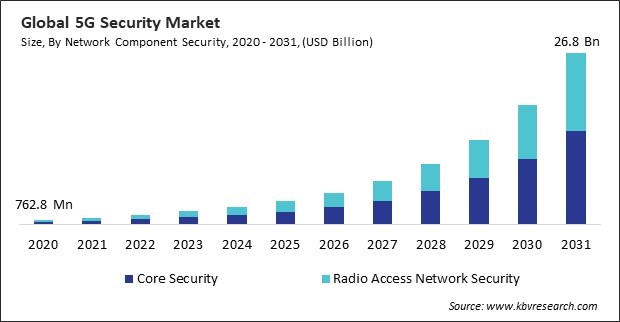
The major strategies followed by the market participants are Partnerships as the key developmental strategy to keep pace with the changing demands of end users. For instance, In October, 2021, IBM Corporation partnered with Palo Alto Networks, a cybersecurity company. The partnership aimed to offer integrated security solutions for 5G networks, promoting Zero Trust strategies and automated security orchestration to protect against evolving threats. Moreover, In September, 2024, Nokia Corporation announced a partnership with Rockwell Automation, an automation solutions provider. The aim of the partnership is to enhance industrial connectivity, improve operational efficiency, and increase network customization and security.
Based on the Analysis presented in the KBV Cardinal matrix; Huawei Technologies Co., Ltd. and AT&T Inc. are the forerunners in the 5G Security Market. In August, 2024, AT&T Inc. partnered with Oracle, a technology company, to leverage the operator’s 5G network and programmable APIs for delivering cloud applications across industries like telehealth and utility management. Their collaboration enables IoT connectivity and near real-time communications, enhancing performance and reliability while simplifying integration for businesses, particularly in public safety. Companies such as IBM Corporation, Qualcomm Incorporated, Nokia Corporation are some of the key innovators in 5G Security Market.
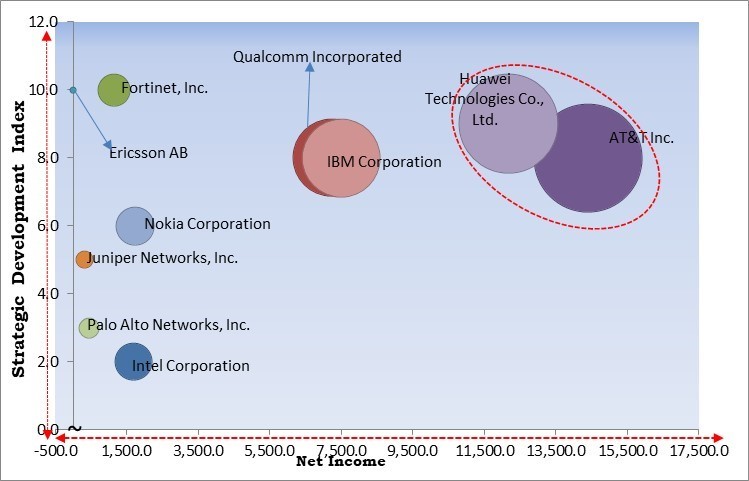
Critical industries such as finance, healthcare, transportation, and manufacturing increasingly rely on real-time data and connectivity to operate efficiently. Implementing 5G technology facilitates faster data transmission and enhanced communication capabilities. However, this increased connectivity also heightens the risk of cyber threats. As organizations in these sectors rely more on 5 G networks for mission-critical operations, the demand for security measures to protect sensitive data and ensure smooth operations is increasing. Thus, the rising demand for secure network infrastructure in critical industries drives the market's growth.
Additionally, As 5G technology becomes more widespread, cybercriminals employ increasingly sophisticated attack techniques to exploit network vulnerabilities. With advanced methods like machine learning, artificial intelligence (AI), and automation, attackers can conduct more targeted and efficient cyberattacks. This evolution in the threat landscape necessitates developing and deploying advanced security solutions to counteract these new cyber threats, driving growth in this market. Hence, increasing cybersecurity threats and data breaches in the age of 5G networks are propelling the market's growth.
Implementing robust security measures for 5G networks requires substantial capital investment in technology, infrastructure, and personnel. Organizations must acquire advanced security tools, such as intrusion detection systems, firewalls, and encryption technologies, which can be expensive. The need for specialized hardware and software tailored to 5G environments adds to these costs. In conclusion, the high costs of implementing comprehensive solutions impede the market's growth.
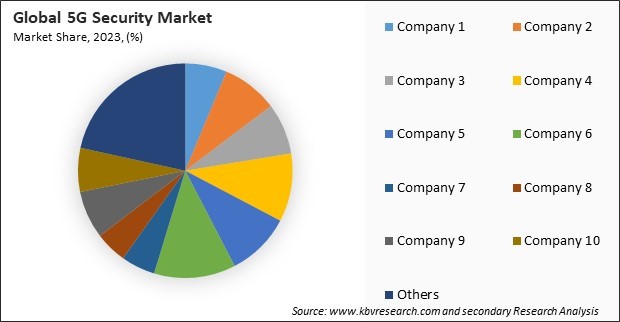
The leading players in the market are competing with diverse innovative offerings to remain competitive in the market. The above illustration shows the percentage of revenue shared by some of the leading companies in the market. The leading players of the market are adopting various strategies in order to cater demand coming from the different industries. The key developmental strategies in the market are Partnerships & Collaborations.
Based on network component security, this market is categorized into radio access network security and core security. The radio access network security segment witnessed 56% revenue share in this market in 2023. RAN's critical role in the 5G network architecture drives this segment's dominance. RAN security is essential to protect the interfaces between user devices and the 5G network, ensuring secure and reliable connectivity.
On the basis of industry vertical, this market is segmented into manufacturing, IT and telecom, healthcare, retail, energy and utilities, automotive, media and entertainment, and others. The manufacturing segment attained 19% revenue share in this market in 2023. As manufacturers increasingly adopt 5G technology to enable smart factories, automation, and IoT integration, the necessity for robust security solutions becomes paramount.
Based on deployment mode, this market is divided into on-premises and cloud. The cloud segment held 43% revenue share in this market in 2023. This significant share is driven by the growing adoption of cloud-based solutions due to their scalability, flexibility, and cost-effectiveness. Organizations increasingly leverage cloud deployment to enhance their 5G security posture, as cloud solutions offer advanced features such as real-time threat detection, automated responses, and seamless updates.
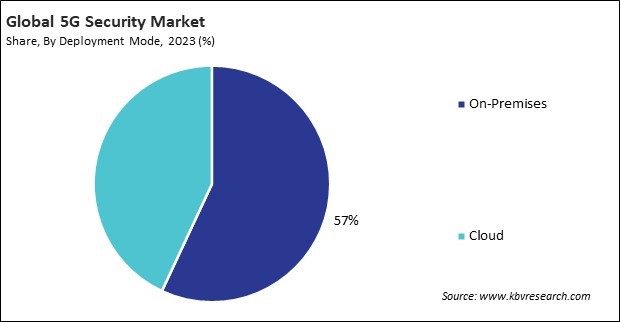
On the basis of organization size, this market is segmented into large enterprises and SMEs. In 2023, the SMEs segment attained 33% revenue share in this market. The increasing awareness among SMEs about securing their 5G networks has driven the demand for effective and affordable security solutions. As these businesses increasingly adopt 5G technology to enhance their operations and competitiveness, they recognize the need to protect their networks from potential cyber threats.,
Based on component, this market is divided into solution and services. In 2023, the services segment procured 33% revenue share in this market. The significant share of this segment can be linked to the growing need for specialized services that support the implementation and maintenance of these solutions. These services include consulting, integration, support, and maintenance, essential for ensuring the effective deployment and ongoing management of security measures.
By architecture, this market is divided into 5G NR standalone and 5G NR non-standalone. The 5G NR non-standalone segment procured 33% revenue share in this market in 2023. The non-standalone architecture, which utilizes the existing LTE infrastructure alongside new 5G capabilities, remains a popular choice for many organizations. This approach allows for a faster and more cost-effective rollout of 5G services while still benefiting from some of the enhanced features of 5G.
Free Valuable Insights: Global 5G Security Market size to reach USD 26.8 Billion by 2031
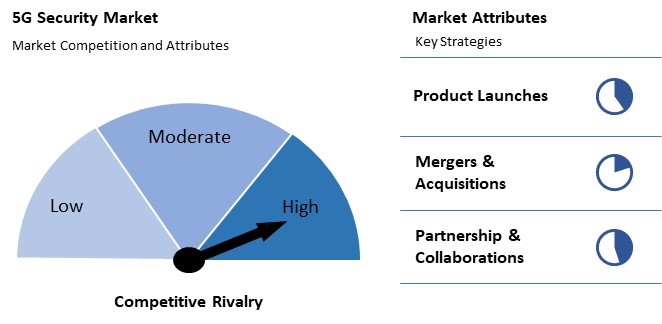
The 5G security market is characterized by intense competition among various emerging players, driving innovation and diversification of solutions. Smaller firms focus on niche offerings, often collaborating with telecom providers to enhance security protocols. This dynamic foster rapid advancements, though the lack of established key players can lead to inconsistent standards and fragmented solutions.
Region-wise, this market is analyzed across North America, Europe, Asia Pacific, and LAMEA. The Asia Pacific region generated 25% revenue share in this market in 2023. The rapid expansion of 5G networks in countries like China, Japan, South Korea, and India has propelled the demand for comprehensive security measures to protect these emerging infrastructures. The region’s large population base, increasing internet penetration, and significant investments in digital transformation initiatives contribute to the growing need for these solutions.
| Report Attribute | Details |
|---|---|
| Market size value in 2023 | USD 2.1 Billion |
| Market size forecast in 2031 | USD 26.8 Billion |
| Base Year | 2023 |
| Historical Period | 2020 to 2022 |
| Forecast Period | 2024 to 2031 |
| Revenue Growth Rate | CAGR of 38.2% from 2024 to 2031 |
| Number of Pages | 370 |
| Number of Tables | 623 |
| Report coverage | Market Trends, Revenue Estimation and Forecast, Segmentation Analysis, Regional and Country Breakdown, Competitive Landscape, Market Share Analysis, Porter’s 5 Forces Analysis, Company Profiling, Companies Strategic Developments, SWOT Analysis, Winning Imperatives |
| Segments covered | Network Component Security, Industry Vertical, Deployment Mode, Organization Size, Component, Architecture, Region |
| Country scope |
|
| Companies Included | AT&T Inc., Ericsson AB, Intel Corporation, Qualcomm Incorporated (Qualcomm Technologies, Inc.), Nokia Corporation, Juniper Networks, Inc., Huawei Technologies Co., Ltd. (Huawei Investment & Holding Co., Ltd.), IBM Corporation, Fortinet, Inc., and Palo Alto Networks, Inc. |
By Network Component Security
By Industry Vertical
By Deployment Mode
By Organization Size
By Component
By Architecture
By Geography
This Market size is expected to reach $26.8 billion by 2031.
Rising Demand For Secure Network Infrastructure In Critical Industries are driving the Market in coming years, however, High Costs Of Implementing Comprehensive 5g Security Solutions restraints the growth of the Market.
AT&T Inc., Ericsson AB, Intel Corporation, Qualcomm Incorporated (Qualcomm Technologies, Inc.), Nokia Corporation, Juniper Networks, Inc., Huawei Technologies Co., Ltd. (Huawei Investment & Holding Co., Ltd.), IBM Corporation, Fortinet, Inc., and Palo Alto Networks, Inc.
The expected CAGR of this Market is 38.2% from 2024 to 2031.
The Core Security segment attained the maximum revenue in the Market by Network Component Security in 2023, thereby, achieving a market value of $14.6 billion by 2031.
The North America region dominated the Market by Region in 2023, and would continue to be a dominant market till 2031; thereby, achieving a market value of $10.6 billion by 2031.
Our team of dedicated experts can provide you with attractive expansion opportunities for your business.
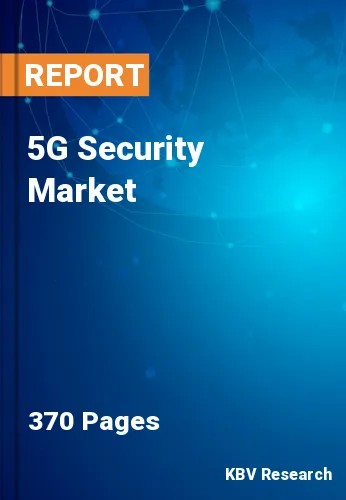
 Drivers
Drivers
 Restraints
Restraints
 Opportunities
Opportunities
 Challenges
Challenges
